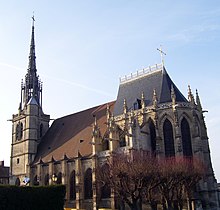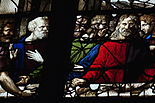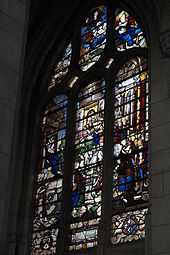Ste-Foy (Conches-en-Ouche)
The Catholic parish church of Sainte-Foy in Conches-en-Ouche , a town in the Eure department in the French region of Normandy , was built in the 16th century on the site of several previous buildings in the Flamboyant Gothic style. The church is dedicated to Saint Fides de Agen (Foy), who was martyred in Agen at the beginning of the 4th century and has been venerated in the abbey church of Sainte-Foy in Conques since the 9th century . Numerous stained glass windows from the 16th century have been preserved in the church. In 1840, the church was added to the list of architectural monuments ( Base Mérimée ) in France as Monument historique .
history
In 1034 Roger de Tosny from Conques brought relics of St. Fides from Agen to Conches-en-Ouche. The church in which they were kept has been rebuilt several times over the centuries. The present church was mostly built in the 16th century. The tower on the south side dates back to the early 16th century, its portal is dated around 1500. The choir and nave were built between 1530 and 1540. Around 1620 the chapel under the north tower was renewed.
Leaded glass window
- Upper choir window: Passion of Christ
|
The upper choir windows depict scenes from the passion of Jesus. Most of them were made around 1535 after engravings by Albrecht Dürer in Gisors in the workshop of Romain Buron , a pupil of Engrand Leprince . |
- Lower choir windows: scenes from the life of Saint Fides
|
The lower choir windows depict episodes from the life of St. Fides and her martyrdom. |
- Window 7: Madonna and Child
|
The window from around 1540 is attributed to Romain Buron. The Madonna and Child in the center is embedded in an antique architectural setting after an engraving by Marcantonio Raimondi . The left lancet depicts a battle scene, while on the right a family is mourning their child. On the lower panes men and women, in the center dignitaries of the church, implore Mary. |
- Window 10: Institution of the Eucharist
|
The theme of the window is the institution of the Eucharist , surrounded by the evangelists John (left) and Luke (right). Abraham's encounter with Melchizedech is depicted in the windows of the tracery . At the bottom left the founder and his son kneel under the protection of their patron, the Apostle Peter and the French King Louis the Saint . The lower right part is occupied by the founder, her daughter and a patron saint with a martyr's palm. |
- Window 11: Mary with her symbols
|
The three-lane window is dated around 1540 and attributed to Romain Buron. Angels, banners and symbols of Mary are shown on all three lancets . Maria takes the middle lancet, she has folded her hands and is dressed in a precious robe, in the three-pass you can see God the Father . |
- Window 12: Last Supper
The Last Supper is depicted on the window after an engraving by Marcantonio Raimondi . The inscription shows that the window was donated by Louis Duval-Martel in 1546. The lower panes show the donor's corpse lying on his grave, next to it the grieving wife kneels. The donor's coat of arms is depicted in the middle pane of the tracery.
- Window 14: Christ in the wine press
|
The 1552 window was damaged when the bell tower collapsed in 1842. In the middle lancet, Christ is depicted in the winepress , his blood is collected in a large wooden tub. On the left, the founder Jean Le Teillier des Ébrieux and twelve male members of his family turn to the events, on the right his wife and six daughters kneel. In the scene at the top right, a wooden barrel is transported on a cart, in which eagles, winged people, bull and lion, the symbols of the evangelists, are clamped. God the Father is depicted in the middle pane of the tracery. |
- Window 15: Triumph of Mary
|
The window was donated in 1553 by Pierre de Coudray and his wife Jeanne de Croixmare. The depiction of the right lancet is inspired by Revelation and shows Mary sitting on an ancient chariot that is running over the dragon. In the background you can see an obelisk , in front of it a stately portal with the inscription "PALAIS VIRGINAL" (Palace of the Virgin). On the middle lancet, the seven virtues are shown in front of a dome with the inscription "TEMPLE D'HONNEUR" (Temple of Honor). The year 1553 can be read under a niche on the facade of the building. The female figures on the right lancet symbolize the Artes Liberales , the seven liberal arts . You stand in front of a building that is supported by tall pillars and columns and is inscribed with the inscription “Palais de Jesse” (Jesse's Palace). Jesse and the kings of Judas are shown in the foreground . |
- Window 16: Picking up the manna in the desert
|
All three lancets as well as the discs of the tracery are dedicated to collecting the manna in the desert. The window is dated around 1550. |
- Window 17: Representation of the Lord
|
The window is believed to come from the workshop of Laurent Marchant in Paris, the successor to Jean Chastellain , and is dated around 1550. It represents the presentation of Jesus in the temple. The tracery records the episode of the presentation of Mary in the temple. |
- Window 19: Madonna with donors
This window was donated by Guillaume Toustain de Frontebosc and his wife Anne de Croixmare around 1508/10. It comes from the previous church and is attributed to the glass painter Arnoud de Nimègue. In the middle Mary is enthroned with the baby Jesus in her arms. On the side lancets are the patrons of the donors, on the left St. Hadrian of Canterbury and on the right St. Romanus , the donors kneel below.
- Window 20: John the Baptist
|
The window was created between 1500 and 1510 for the previous church. It depicts scenes from the life of John the Baptist , with the baptism of Jesus in the center. On the left lancet, beneath the scene of the sermon of John the Baptist, donor figures kneel, on the right lancet John refers to Jesus. |
organ
The organ was built in 1863 by the organ builder M. Duchatelier. The instrument has been restored several times over the years. In 2010 the organ was reconstructed by the organ builders Boisseau and Gaborit. The instrument has 25 stops on three manual works and a pedal . The manual Récit comprises 44 tones. The actions are mechanical.
|
|
|
|
||||||||||||||||||||||||||||||||||||||||||||||||||||||||||
- Coupling : II / I, III / I, I / P, II / P, III / P (super octave coupling)
literature
- Martine Callias Bey, Véronique Chaussé, Françoise Gatouillat, Michel Hérold: Corpus Vitrearum. Les vitraux de Haute-Normandie . Éditions du patrimoine, Paris 2001, ISBN 2-85822-314-9 , pp. 128-135.
Web links
- Église Sainte-Foy in the Base Mérimée of the French Ministry of Culture (French)
- Presentation of the parish community on the diocese website
Individual evidence
- ^ Église Sainte-Foy in the Base Mérimée of the French Ministry of Culture (French)
- ↑ Information on the organ (French)
Coordinates: 48 ° 57 ′ 45 ″ N , 0 ° 56 ′ 31.2 ″ E




















